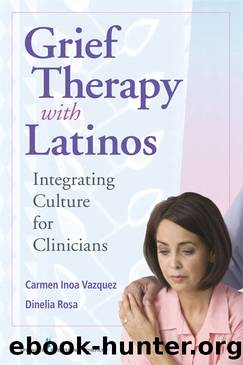Grief Therapy with Latinos by Vazquez Carmen;Rosa Dinelia;

Author:Vazquez, Carmen;Rosa, Dinelia;
Language: eng
Format: epub
Publisher: Springer Publishing Company, Incorporated
Published: 2011-04-27T00:00:00+00:00
Dealing with Abortions
According to the CDC's Abortion Surveillance report for 2000 regarding legal induced abortions, an estimated 26 million legal abortions occur each year worldwide (U.S. Department of Health, Education, and Welfare, CDC, 2003). The abortion ratio for Hispanic women (225 per 1000 live births) was lower than the ratio for non-Hispanic women (233 per 1000 live births). A study of post-abortion patients aged 14â45 years old found that, eight weeks after their abortions, 44% reported nervous disorders, 36% experienced sleep disturbance, 31% regretted their decision to abort, and 11% had been prescribed psychotropic medications (Ashton, 1980). Although psychological symptoms and emotions can follow a linear pattern of change, they can also occur in different ways. In a study exploring how women reflect upon their past abortions in the long term, the results showed that some women followed a linear pattern of feeling better as time went on, while others described a nonlinear pattern, including persistent upset and distress that remained ongoing many years after the event, negative reappraisal some time after the event, and positive appraisal at the time of the event with no subsequent negative emotions (Goodwin & Ogden, 2007). Women who reported more distress or patterns of emotional change involving persistent upset and negative appraisal were intertwined with a more human view of the fetus, had lack of social support, and a belief that society is overly judgmental.
Major et al. (2009) presented four perspectives that have shaped the understanding of the potential association between abortion and mental health. In the first perspective, abortion is considered a traumatic experience, unique because it involves a death experience with an intentional destruction of an unborn child. Speckhard and Rue (1992) coined the term âpost-abortion syndromeâ (PAS) to describe the specific posttraumatic disorder presented by women who had an abortion. A second perspective views abortion as a potential stressful life event within the range of other normal life stressors. Because abortion occurs in the context of a second stressful life eventâthe reason why the abortion has to take placeâit can be difficult to separate out psychological experiences related to abortion from those related to other aspects of the unintended pregnancy (Adler et al., 1990). A third perspective views abortion as being associated with co-occurring risk factors. The last perspective views abortion as occurring within a sociocultural context (Major et al., 2009). According to this latter view, the sociocultural context complements the stress-and-coping perspective in that it affects the elements of the stress-and-coping process with regard to pregnancy and its outcomes in multiple ways that can increase or reduce the stressfulness of the abortion (Major et al., 2009). For example, a sociocultural context that condemns women who have abortions will increase her chances of becoming increasingly disappointed, shameful, and guilty. These two last perspectives can help understand cultural dynamics that contribute to the mental health and well being of Latinas having abortions. The impact of grief after the abortion depends on many factors that are conditioned by cultural norms.
Latinas have often been
Download
This site does not store any files on its server. We only index and link to content provided by other sites. Please contact the content providers to delete copyright contents if any and email us, we'll remove relevant links or contents immediately.
Chaco's Northern Prodigies : Salmon, Aztec, and the Ascendancy of the Middle San Juan Region after AD 1100 by Paul F. Reed(338)
Law Enforcement Interpersonal Communication and Conflict Management by Brian Douglas Fitch(331)
Digital International Relations by Unknown(324)
Critical Perspectives on Human Security : Rethinking Emancipation and Power in International Relations by David Chandler; Nik Hynek(315)
The Enduring Color Line in U.S. Athletics by Krystal Beamon Chris M. Messer(309)
Skilled interpersonal communication: Research, theory and practice, Fifth edition by Owen Hargie(309)
Evidence-Based Policy Making in Labor Economics by Hamermesh Daniel S.;Nottmeyer Olga K.;Nottmeyer Olga;King Sarah;King Sarah;King Sarah;(277)
EPSO CAST Political affairs EU policies: How to succeed in the selection procedure by Franco Reverte José María(272)
Writing Public Policy - A Practical Guide to Communicating in the Policy Making Process by Catherine F. Smith(256)
Threshold Concepts in Women's and Gender Studies by Christie Launius Holly Hassel(249)
Criminological Theory in Context by John Martyn Chamberlain(249)
Tibeton Yoga Its Secret Doc by Evans-Wentz(245)
Positive Psychology and Spirituality in Counselling and Psychotherapy (Conflict, Ethics, and Spirituality, 12) by unknow(245)
Rothschild and Early Jewish Colonization in Palestine (Geographical Perspectives on the Human Past) by Ran Aaronsohn(244)
Social Problems, Social Issues, Social Science by James Wright(243)
Play in child development and psychotherapy: toward empirically supported practice by Sandra W. Russ(239)
Cognitive Development in Infancy and Childhood (Elements in Child Development) by Mary Gauvain(235)
Latin American Politics and Society by Gerardo L. Munck & Juan Pablo Luna(208)
What Makes a Social Crisis?: The Societalization of Social Problems by Jeffrey C. Alexander(206)
